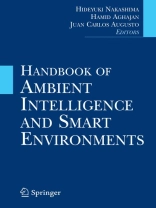Our homes anticipate when we want to wake up. Our computers predict what music we want to buy. Our cars adapt to the way we drive. In today’s world, even washing machines, rice cookers and toys have the capability of autonomous decision-making. As we grow accustomed to computing power embedded in our surroundings, it becomes clear that these ‘smart environments’, with a number of devices controlled by a coordinating system capable of ‘ambient intelligence’, will play an ever larger role in our lives. This handbook provides readers with comprehensive, up-to-date coverage in what is a key technological field. . Systematically dealing with each aspect of ambient intelligence and smart environments, the text covers everything, from visual information capture and human/computer interaction to multi-agent systems, network use of sensor data, and building more rationality into artificial systems. The book also details a wide range of applications, examines case studies of recent major projects from around the world, and analyzes both the likely impact of the technology on our lives, and its ethical implications.
With a wide variety of separate disciplines all conducting research relevant to this field, this handbook encourages collaboration between disparate researchers by setting out the fundamental concepts from each area that are relevant to ambient intelligence and smart environments, providing a fertile soil in which ground-breaking new work candevelop.
Table of Content
Ambient Intelligence and Smart Environments: A State of the Art.- Sensor, Vision and Networks.- A Survey of Distributed Computer Vision Algorithms.- Video-Based People Tracking.- Locomotion Activities in Smart Environments.- Tracking in Urban Environments Using Sensor Networks Based on Audio-Video Fusion.- Multi-Camera Vision for Surveillance.- Mobile and Pervasive Computing.- Collaboration Support for Mobile Users in Ubiquitous Environments.- Pervasive Computing Middleware.- Case Study of Middleware Infrastructure for Ambient Intelligence Environments.- Collaborative Context Recognition for Mobile Devices.- Security Issues in Ubiquitous Computing*.- Pervasive Systems in Health Care.- Human-centered Interfaces.- Human-centered Computing.- End-user Customisation of Intelligent Environments.- Intelligent Interfaces to Empower People with Disabilities.- Visual Attention, Speaking Activity, and Group Conversational Analysis in Multi-Sensor Environments.- Using Multi-modal Sensing for Human Activity Modeling in the Real World.- Recognizing Facial Expressions Automatically from Video.- Sharing Content and Experiences in Smart Environments.- User Interfaces and HCI for Ambient Intelligence and Smart Environments.- Multimodal Dialogue for Ambient Intelligence and Smart Environments.- Artificial Intelligence and Robotics.- Smart Monitoring for Physical Infrastructures.- Spatio-Temporal Reasoning and Context Awareness.- From Autonomous Robots to Artificial Ecosystems.- Behavior Modeling for Detection, Identification, Prediction, and Reaction (DIPR) in AI Systems Solutions.- Multi-Agents.- Multi-Agent Social Simulation.- Multi-Agent Strategic Modeling in a Specific Environment.- Learning Activity Models for Multiple Agents in a Smart Space.- Mobile Agents.- Applications.- Ambient Human-to-Human Communication.- Smart Environments for Occupancy Sensing and Services.- Smart Offices and Intelligent Decision Rooms.- Smart Classroom: Bringing Pervasive Computing into Distance Learning.- Ambient Intelligence in the City Overview and New Perspectives.- The Advancement of World Digital Cities.- Societal Implications and Impact.- Human Factors Consideration for the Design of Collaborative Machine Assistants.- Privacy Sensitive Surveillance for Assisted Living – A Smart Camera Approach.- Data Mining for User Modeling and Personalization in Ubiquitous Spaces.- Experience Research: a Methodology for Developing Human-centered Interfaces.- Projects.- Computers in the Human Interaction Loop.- Eye-based Direct Interaction for Environmental Control in Heterogeneous Smart Environments.- Middleware Architecture for Ambient Intelligence in the Networked Home.- The PERSONA Service Platform for AAL Spaces.- ALADIN – a Magic Lamp for the Elderly?.- Japanese Ubiquotous Network Project: Ubila.- Ubiquitous Korea Project.- Erratum.












